Training the muscles of the chest is an important part of any good exercise program. And, when aiming to train on muscle in a muscle group, you usually end up training all of them. For instance, you can try to specifically target the upper chest, but most upper chest exercises will engage the entire chest. Whether or not different chest exercises produce differential growth in specific areas of the muscle is an area of active debate.
A number of studies have investigated the electrical activity, e.g., “excitation” of the anterior deltoid, pec major (and parts thereof), and other muscles during flat, incline, and decline bench press, with mixed results. Additionally, these EMG differences (a measure of muscle excitation) are not really predictive of actual outcomes, e.g., differences in muscle size and strength when using one or more variation(s) over the other.
Still, we can hedge our bets for training specific areas of the chest and in this article, we’ll outline our six favorite exercises: the incline dumbbell fly, incline bench press, close-grip bench press, cable crossover, decline push-up and bar dips.
What are the Best Upper Chest Workout Exercises?
Here are the most effective exercises to work you upper chest (pecs):
- Incline Dumbbell Fly: 2-4 sets x 10-15 repetitions
- Incline Bench Press: 3-4 sets x 5-8 repetitions
- Wide-Grip Bench Press: 2-4 sets x 6-10 repetitions
- Low-to-High Cable Fly: 2-4 sets x 10-15 repetitions
- Decline Pushup: 3 sets x 10 – 30 repetitions
- Bar Dips: 2-4 sets of 6-10 repetitions
To ensure maximum gains, train the muscles through a relatively large range of motion; do different exercises that load the muscle at a variety of angles; and finally, train with a load that gets you close to failure. Your workout intensity and volume (reps and sets) will depend on your body, training level, and training split (e.g. full body or body part split).
If you’re just starting off, our beginner template is an example of the volume, frequency, load, and overall training split we would recommend. Specifically, we recommend 3 – 4 chest exercises per week, performed for a weekly total of ~10 to 15 sets, using a variety of different repetition ranges. For more advanced lifters, the total number of sets and exercises is likely to be greater. This is demonstrated in our hypertrophy and bodybuilding templates.
1. Incline Dumbbell Fly
If you’ve been lifting for a while, you know that incline bench exercises reign supreme when it comes to upper–chest activation. The great thing about the incline dumbbell fly is that in addition to activating the upper pectoralis major, it also works the anterior deltoid muscles and biceps. Plus, adding dumbbells to the incline bench offers more variety in terms of range of motion, so you can hit multiple muscle groups at once.
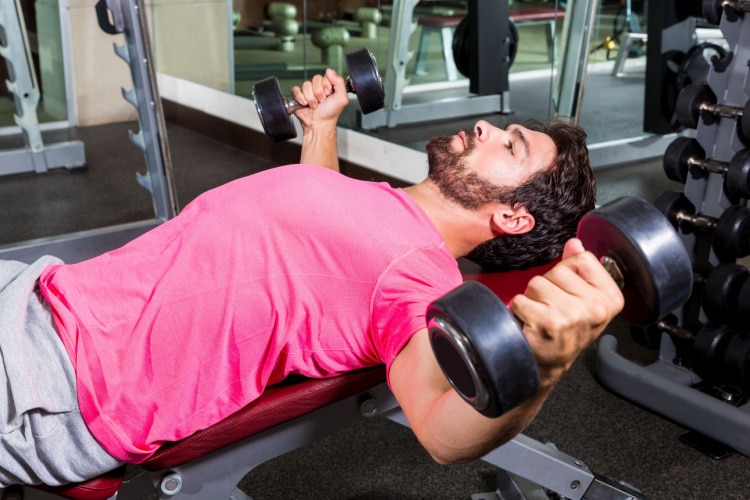
Movement Category: Tertiary
Programming: 2-4 sets of 10-15 repetitions
Weight: Use a weight that leaves you 1 to 2 reps short of failure, e.g. RPE 8 to 9.
To do an incline dumbbell fly:
- Set your bench inclination to anywhere between 15 to 30 degrees.
- Lie down on the bench with dumbbells in each hand. Keep the dumbbells at your sides, level with your chest. Your elbows should be bent at 90 degrees.
- Press the dumbbells up until they’re just short of lockout. Your palms should be facing each other and there should be a slight bend at your elbow. This is your starting position.
- Take a deep breath and slowly open up your elbows to each side, lowering them laterally until you feel a stretch in your pectoral muscles.
- Avoid lowering your dumbbells below chest height, as this could lead to an injury. At the lowest position, your arms should be bent very slightly at the elbow.
- Hold for a second and slowly swing your arms back up to the starting position.
- Squeeze your pecs and hold the dumbbells at the top for a second.
2. Incline Bench Press
This variation of the bench press also makes use of bench inclination to work your upper pectoralis major. While the bench press mainly works the pectoralis major, the clavicular head is more isolated. [1] It also activates the anterior deltoid, which is our main shoulder muscle.
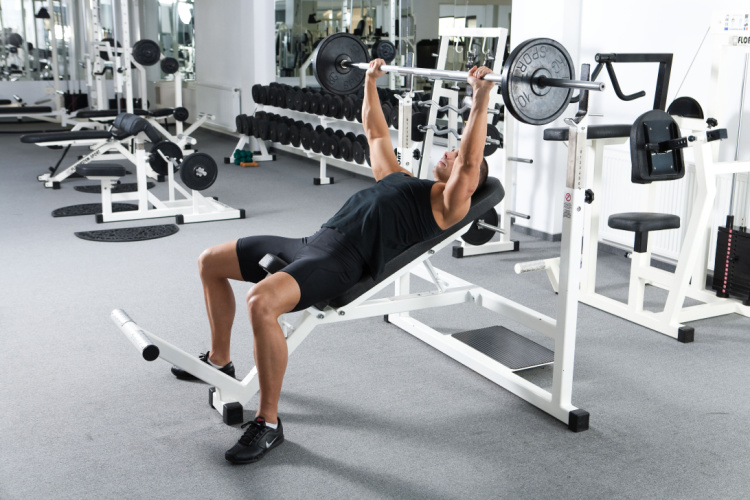
Movement Category: Primary
Programming: 3-4 sets of 5-8 repetitions
Weight: Use a weight that leaves you 2 to 3 reps short of failure, e.g. RPE 7 to 8.
To do an incline bench press:
- Set the bench inclination to anywhere between 15 to 30 degrees.
- Lie flat and pin your shoulder blades onto the bench. Your feet should be firmly planted onto the ground.
- Take a deep breath and lift on the exhale.
- If necessary, work with a spotter.
- Give yourself a few seconds to adjust to the weight. Make sure your upper back muscles are still tight.
- Inhale and slowly lower the barbell back down. At the lowest position, the barbell should be at the base of your breastbone.
3. Wide-Grip Bench Press
The wide-grip bench press is another bench press variation that, when done properly, works the upper chest and shoulders. A wide grip allows for a bit more stretch of the pectoralis major, likely putting more stress on its clavicular head and the anterior deltoid. A wide-grip push-up could be a good alternative for those who don’t have access to a bar and a rack. [2,3]
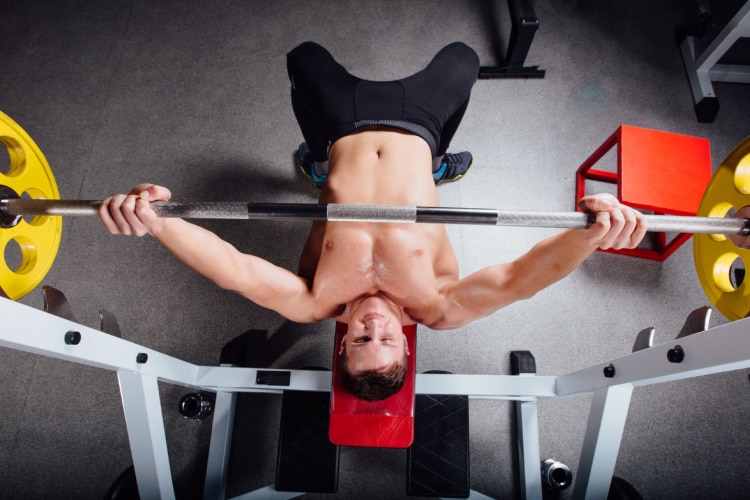
Movement Category: Secondary
Programming: 2-4 sets of 6-10 repetitions
Weight: Use a weight that leaves you 2 to 3 reps short of failure, e.g. RPE 7 to 8.
To do a wide-grip bench press:
- Lie on the bench with a slight arch in your lower back. Make sure your shoulders are pressed flat on the bench.
- Grip the bar with your hands right over your pecs. The grip should be around a hand’s width wider than shoulder-width apart.
- Inhale, take the bar off the rack, and lower it down to your chest slowly. Keep holding your breath while you do this. This is your starting position.
- On the exhale, explosively push the bar up until your arms are locked out.
- Slowly lower the bar back down to the starting position as you inhale.
4. Low-to-High Cable Fly
The cable fly is an exercise that requires a great range of motion and activates the entire chest. However, the cable machine is an extremely versatile piece of equipment that can help you isolate many different muscles in the upper body. The secret lies in the pulley’s position. A general rule of thumb is: the lower your pulleys are, the higher the muscle groups that are targeted.
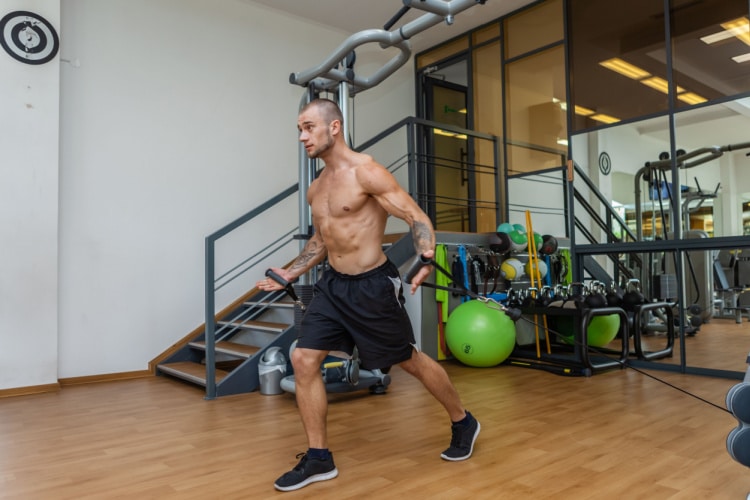
Movement Category: Tertiary
Programming: 2-4 sets of 10-15 repetitions
Weight: Use a weight that leaves you 1 to 2 reps short of failure, e.g. RPE 8 to 9.
To do a low-to-high cable crossover:
- Adjust the cable pulleys to waist height.
- Hold them with your arms extended out to the sides at a 45-degree angle. Your hands should be at waist height, too.
- Take a big step forward with one leg and keep your chest upright. Your front leg should be slightly bent at the knee. This is your starting position.
- Take a breath and on the exhale, bring up your arms and connect them in front of you while keeping them straight and at chest level.
- Keep in mind that your arms should form a 90-degree angle at the highest point of the movement
- Slowly draw your arms back to the starting position.
5. Decline Push-up
Decline push-ups are an excellent calisthenic exercise for individuals looking to work their upper pecs without having to lift weights. The decline allows most of the mechanical load to be put on the upper pectorals, triceps, and delts, which means you can simultaneously train your shoulders and upper arms.
Furthermore, decline push-ups increase ground resistance, which in turn increases the overall intensity of the move. That’s why the decline push-up is a more efficient exercise for training the chest than a regular push-up.[4] For an extra boost, try hooking resistance bands over your shoulders and under your hands.
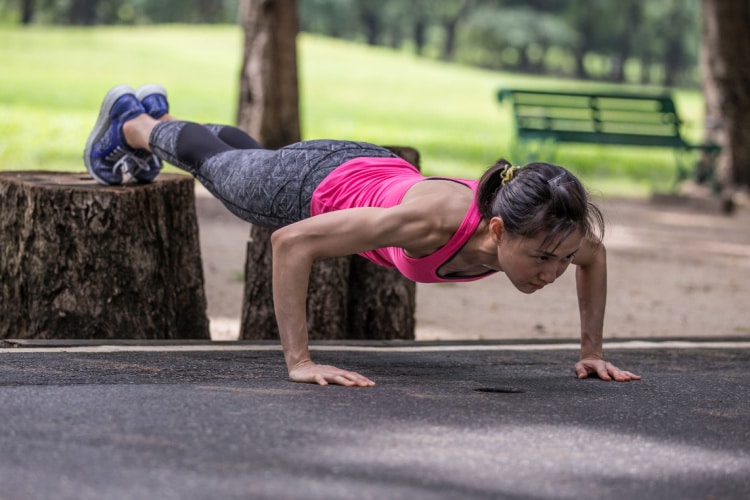
Movement Category: Tertiary
Programming: 3 sets of as many reps as it takes to get within 2 to 3 reps short of failure, e.g. RPE 7 to 8.
Weight: Bodyweight
To do a decline push-up:
- Place your hands on the ground and your toes on a bench. Keep your spine straight and your core tight. You’re practically in a plank position – only your legs are elevated.
- Keep your arms shoulder-width apart. This is your starting position.
- Slowly lower yourself and get your chest as close to the ground as possible.
- Slowly push up until your arms are nearly locked out.
6. Bar Dips
Bar dips are another great calisthenic exercise that targets the whole chest with a focus on the upper pectorals and delts. In fact, bar dips are among the most efficient chest exercises you can do with just your body weight. So, if you’re not too keen on picking up the barbell, bar dips could be one of your staple chest day exercises.
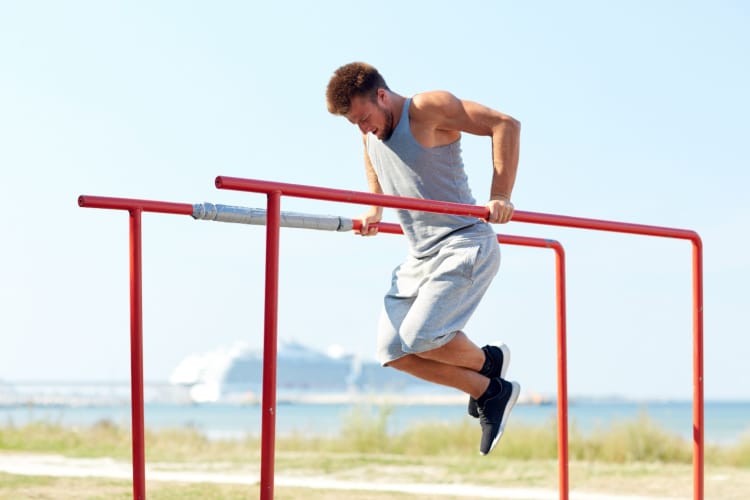
Movement Category: Secondary
Programming: 2-4 sets of 6-10 repetitions
Weight: Use a weight that leaves you 2 to 3 reps short of failure, e.g. RPE 7 to 8.
To do a bar dip:
- Hold onto the bars and push up until your arms are locked out.
- Tuck your legs under and cross your ankles.
- Slowly, lower yourself as much as possible (which would be when their elbows are bent at 90 degrees for most people) and hold for a second at the lowest position.
- Slowly raise yourself up until your arms are locked out again.
Combining Exercises
Including a combination of these upper-chest exercises in your workout routine will allow you to train the entire chest and emphasize the upper pectorals. Regardless of whether you’re using a full-body or body-part split, the total training stress must be carefully managed to achieve the best results.
Training stress is a product of how an individual responds to the volume, frequency, load, and proximity to failure used in a training program based on their genetics, training history, current fitness levels, and other factors. In general, more advanced well-trained individuals will need more volume to increase strength and hypertrophy, which may require more exercises and more frequent training. On the other hand, beginners and newer lifters will require less. In both cases, the training must be matched to the individual.
We recommend using a combination of compound and isolation exercises for both new and advanced lifters. For beginners, we recommend ~3 – 4 chest exercises per week, performed for a weekly total of ~10 to 15 sets, using a variety of different repetition ranges. If using a body-part split, all of the chest exercises would be performed in a single session, e.g. chest day. If using a full-body split, one or two exercises would be performed each session. In both cases, the total weekly volume and number of exercises should be similar, thereby generating similar levels of stress. For more advanced lifters, the total number of sets and exercises are likely to be greater, as demonstrated in our hypertrophy and bodybuilding templates.
Finally, try to continually challenge your muscles through progressive loading practices to achieve the best results.
But why should we isolate the upper chest? Isn’t it enough to just keep benching?, you may ask. Especially if you’re not aiming to get bigger, isolation movements and exercise variance may not seem crucial. Chest isolation exercises are mainly beneficial for muscle hypertrophy over strength, particularly if the strength is tested using a compound exercise, like the bench press. This is not to say that isolation exercises have no place in strength-focused programs as well, since many strength enthusiasts also want increased muscle hypertrophy.
Why Should We Train Our Upper Chest?
Now that we’ve covered how we can efficiently train our upper chest, let’s look a bit into why. Sure, most chest exercises will train and grow the whole chest to some degree. However, those seeking additional hypertrophy in the upper chest could benefit from doing isolation exercises that target the area.
1. Aesthetics
For individuals seeking a larger chest, doing exercises that target the clavicular head and upper portion of the pectoralis major would be a good idea. A great added bonus is that these exercises also engage the shoulders, specifically the anterior deltoid, and thus contribute to their development as well. [5, 6]
2. Improved Shoulder Strength
As most exercises that target the upper chest also rely on a significant contribution from the anterior deltoid muscles in our shoulders, it’s highly likely that shoulder strength (in addition to size) will increase also.
3. Better Quality Lifts
After going over how upper chest exercises can improve shoulder strength, the next logical point to mention would be that they can generally improve the quality of your lifts. Most lifts rely on shoulder strength to execute, so any exercise that builds strength in your shoulders can greatly improve the quality of your lifts. [7] Another factor to mention is that the clavicular head of the pectoralis major causes the flexion of an extended arm, and this movement is actually necessary for a lot of lifts. [8]
Tips For Training The Upper Chest
Training the upper chest directly can help with both aesthetics and performance. However, if you want to train the upper chest, you need to do it right.
Keep in mind that training the upper chest involves engaging a very specific muscle group. Targeting it the right way may look different for each person, depending on their anthropometry, fitness level, training experience, and overall response to training. So, here are three pieces of advice that will help you hit the spot with your upper chest exercises.
Find the Right Incline for You
Many fitness resources recommend a 15 to 30-degree incline relative to the floor for working out the upper chest. As the bench’s incline gets closer to horizontal, muscle excitation levels become higher for the pectoralis major and lower for the anterior deltoid of the shoulder, in general. [9] However, this doesn’t mean a lower or higher incline is better or worse for targeting the upper pectoralis major, as excitation levels don’t necessarily correlate to training outcomes like strength or hypertrophy.
Start with a 30-degree incline and see how you respond. Individuals will respond differently to the same exercise – so you should also find the right incline for your body.
Get the Right Amount of Sets and Reps
While the pectorals cover a fairly large area on our upper bodies, the clavicular head of the pectoralis major is only a small part of the entire muscle. Still, it’s very difficult for any exercise to isolate only a specific part of the entire muscle, as the whole muscle gets worked to some degree.
Muscular hypertrophy and strength have been shown to have a dose-dependent relationship with training volume. [10,11] In other words, greater amounts of training volume tend to result in greater amounts of strength and hypertrophy, but only if the individual can tolerate it. In short, the amount of total training stress must be tolerable by the individual so as not to outstrip their recovery resources.
Most rep ranges have similar effects on hypertrophy, so it’s not necessary to do high reps to prioritize muscle growth. [12] Still, some exercises – particularly single joint isolation exercises– lend themselves to higher rep ranges and training closer to failure. In contrast, compound exercises offer a unique opportunity to lift heavier weights for fewer repetitions.
To generate the full complement of training adaptations, we recommend doing a variety of rep ranges, using a higher number of reps (e.g. 8 to 15 reps) for isolation exercises and fewer reps (e.g. 4 to 8 reps) for most compound exercises. Isolation exercises can be taken closer to failure, e.g. RPE 8-10, whereas compound exercises can work well when staying a bit further away from failure, e.g. RPE 6-8.
Find Your Mind-Muscle Connection
Finding your mind-muscle connection is important for any type of sport. However, it’s especially important for engaging isolated muscles. Shifting the attentional focus to a particular muscle or area of the muscle may increase muscle excitation levels, potentially leading to greater results. [13]
Train With Barbell Medicine
It’s no secret that the smaller the muscle, the harder it is to develop. Trainees with less lifting experience will accidentally engage bigger muscle groups instead of hitting their target.
An easy way to make sure you’re getting the most out of your upper-chest workout is a team that takes you through the process of upper-chest activation step by step, measures your performance, and tweaks your workout program to ensure the best results.
Luckily, that is what we do best. At Barbell Medicine, we offer evidence-backed programs by staying up-to-date on the latest developments in sports science. Our team of licensed trainers, doctors, and dietitians will craft a bespoke program for your specific body and needs that will give you the upper-chest gains you’re looking for. Get in touch with us today to get a personalized training program.
Alternatively, if you’re more of a DIY kind of person, check out our pre-made workout templates. While none are specifically catered toward the upper chest, our hypertrophy programs include a great variety of isolation exercises that will help you develop your pecs!
Conclusion
While it may seem small and insignificant, the upper chest is an important muscle group to train for a variety of reasons. Firstly, they are directly connected to the shoulder muscles and joints, and training them could improve your joint stability and overall upper-body strength. Not to mention that the upper pectorals are probably the most important muscles to train to get that full, ripped-chest look.
So, our top six exercises to help you get that chest are the incline dumbbell fly, incline bench press, close grip bench press, cable crossover, decline push-up, and bar dips.
Once you incorporate these exercises into your routine, you’ll start seeing development in your upper chest. However, you should also make sure to get in the right amount of sets and reps, find the right inclination to target your upper chest, and develop the mind-muscle connection necessary to isolate smaller muscle groups.
References:
- Rodríguez-Ridao, D., Antequera-Vique, J. A., Martín-Fuentes, I., & Muyor, J. M. (2020). Effect of Five Bench Inclinations on the Electromyographic Activity of the Pectoralis Major, Anterior Deltoid, and Triceps Brachii during the Bench Press Exercise. International journal of environmental research and public health, 17(19), 7339. https://doi.org/10.3390/ijerph17197339
- Kim, Y. S., Kim, D. Y., & Ha, M. S. (2016). Effect of the push-up exercise at different palmar width on muscle activities. Journal of physical therapy science, 28(2), 446–449. https://doi.org/10.1589/jpts.28.446
- Larsen, S., Gomo, O., & van den Tillaar, R. (2021). A Biomechanical Analysis of Wide, Medium, and Narrow Grip Width Effects on Kinematics, Horizontal Kinetics, and Muscle Activity on the Sticking Region in Recreationally Trained Males During 1-RM Bench Pressing. Frontiers in Sports and Active Living, 2. https://www.frontiersin.org/articles/10.3389/fspor.2020.637066
DOI: 10.3389/fspor.2020.637066
ISSN: 2624-9367
- Ebben, William P1; Wurm, Bradley2; VanderZanden, Tyler L2; Spadavecchia, Mark L2; Durocher, John J2; Bickham, Curtis T1; Petushek, Erich J4. Kinetic Analysis of Several Variations of Push-Ups. Journal of Strength and Conditioning Research 25(10):p 2891-2894, October 2011. |
DOI: 10.1519/JSC.0b013e31820c8587
- Rodríguez-Ridao, D., Antequera-Vique, J. A., Martín-Fuentes, I., & Muyor, J. M. (2020). Effect of Five Bench Inclinations on the Electromyographic Activity of the Pectoralis Major, Anterior Deltoid, and Triceps Brachii during the Bench Press Exercise. International journal of environmental research and public health, 17(19), 7339. https://doi.org/10.3390/ijerph17197339
- Luczak, J., Bosak, A., & Riemann, B. L. (2013). Shoulder Muscle Activation of Novice and Resistance Trained Women during Variations of Dumbbell Press Exercises. Journal of sports medicine (Hindawi Publishing Corporation), 2013, 612650. https://doi.org/10.1155/2013/612650
- Schütz, P., Zimmer, P., Zeidler, F., Plüss, M., Oberhofer, K., List, R., & Lorenzetti, S. R. (2022). Chest Exercises: Movement and Loading of Shoulder, Elbow and Wrist Joints. Sports (Basel, Switzerland), 10(2), 19. https://doi.org/10.3390/sports10020019
- Solari F, Burns B. Anatomy, Thorax, Pectoralis Major Major. [Updated 2023 Jul 24]. In: StatPearls [Internet]. Treasure Island (FL): StatPearls Publishing; 2023 Jan-. Available from: https://www.ncbi.nlm.nih.gov/books/NBK525991/
- Rodríguez-Ridao, D., Antequera-Vique, J. A., Martín-Fuentes, I., & Muyor, J. M. (2020). Effect of Five Bench Inclinations on the Electromyographic Activity of the Pectoralis Major, Anterior Deltoid, and Triceps Brachii during the Bench Press Exercise. International journal of environmental research and public health, 17(19), 7339. https://doi.org/10.3390/ijerph17197339
- Figueiredo, Vandré Casagrande et al. “Volume for Muscle Hypertrophy and Health Outcomes: The Most Effective Variable in Resistance Training.” Sports medicine (Auckland, N.Z.) vol. 48,3 (2018): 499-505. doi:10.1007/s40279-017-0793-0
- Schoenfeld, Brad J et al. “Resistance Training Volume Enhances Muscle Hypertrophy but Not Strength in Trained Men.” Medicine and science in sports and exercise vol. 51,1 (2019): 94-103. doi:10.1249/MSS.0000000000001764
- Schoenfeld, Brad J et al. “Effect of repetition duration during resistance training on muscle hypertrophy: a systematic review and meta-analysis.” Sports medicine (Auckland, N.Z.) vol. 45,4 (2015): 577-85. doi:10.1007/s40279-015-0304-0
- Snyder, Benjamin J, and Wesley R Fry. “Effect of verbal instruction on muscle activity during the bench press exercise.” Journal of strength and conditioning research vol. 26,9 (2012): 2394-400. doi:10.1519/JSC.0b013e31823f8d11